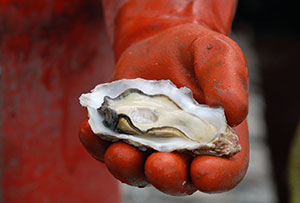Aquatic Farming
Information

About Aquatic Farming
Mission: The Alaska Department of Fish and Game permits and regulates aquatic farming in the state in a manner that ensures the protection of the state's fish, game, and aquatic plant resources and improves the economy, health, and well-being of the people of the state.
What we do: We permit aquatic farming activities within the state of Alaska and provide regulatory, technical, and planning services to people interested in aquatic farming.
People are required to have permits for aquatic farming activities including to:
- construct or operate an aquatic farm in Alaska waters
- construct or operate a nursery or hatchery to supply shellfish to an aquatic farm
- purchase or sell shellfish stock to be held or raised at a shellfish hatchery or nursery
- acquire, transfer or purchase shellfish stock to be used at an aquatic farm
Core Services:
- Determine that the physical and biological characteristics of the farm location are suitable for farming
- Ensure that aquatic farming does not significantly alter an established use of a fishery resource
- Ensure that aquatic farming is compatible with fish and wildlife resources and their habitat
- Determine wild stock populations of the proposed farmed species prior to permitting aquatic farm operations, to ensure sustainability of the local populations
- Determine if aquatic farms are technically feasible, through the review of farming methods and practices
What is Aquatic Farming?
Aquatic farming is the culturing of shellfish and aquatic plant organisms in captivity or under positive control in the near shore environment. In Alaska, the aquatic farming industry primarily produces Pacific oysters, littleneck clams, and mussels for commercial food production. Methods used to culture Pacific oysters and mussels in Alaska consist of a variety of suspended systems such as floating rafts or longlines used to support cages, trays or nets. Clams are grown in intertidal and subtidal areas, depending on the organism farmed.
Presentations on ADF&G Aquatic Farming
- ADF&G Aquatic Farming Update, 2023 (PDF 2,901 kB)
- Understanding Aquatic Farming ADF&G Permitting (PDF 1,715 kB)
- 2020, Alaska Department of Fish and Game Aquatic Farming Permitted Operations Status Report (PDF 1,473 kB)
- 2019 Understanding Aquatic Farming ADF&G Permitting, Kodiak Mariculture Conference (PDF 7,855 kB)
- 2018 Insights into Aquatic Farming of Shellfish and Aquatic Plants in Alaska (PDF 3,381 kB)
- 2018 Aquatic Farming Industry Status (PDF 1,710 kB)
- 2015 Aquatic Farming in Alaska Production Year Summary (ASGA Conference) (PDF 154 kB)
- 2014 Aquatic Farming in Alaska Production Year Summary (ASGA Conference) (PDF 2,836 kB)
- 2014 A Look at Aquatic Farming in Alaska - American Fisheries Society (PDF 3,855 kB)
- 2013 Aquatic Farming Industry Highlights (PDF 554 kB)
- 2013 Kachemak Bay Pacific Oyster Production (PDF 658 kB)
- 2013 Aquatic Farming ' House Fisheries (PDF 2,606 kB)
- 2013 Status of Aquatic Farming in Alaska (PDF 2,130 kB)
- 2012 Fits and Starts: Status of Aquatic Farming in Alaska (PDF 7,417 kB)
- 2011 Aquatic Farm Opening (PDF 5,839 kB)
- 2009 Mariculture Program Overview (PDF 3,812 kB)
- 2008 Mariculture Program Overview (PDF 5,474 kB)
- 2007 Mariculture Program Overview (PDF 3,814 kB)
- 2006 Geoduck Aquatic Farm Management (PDF 2,442 kB)
- 2002 Mariculture Program Overview (PDF 1,716 kB)
This webpage requires Microsoft PowerPoint Online or Microsoft Power Point (mobile) to display some content. You can find more information about viewing PowerPoint documents on the Microsoft website.
